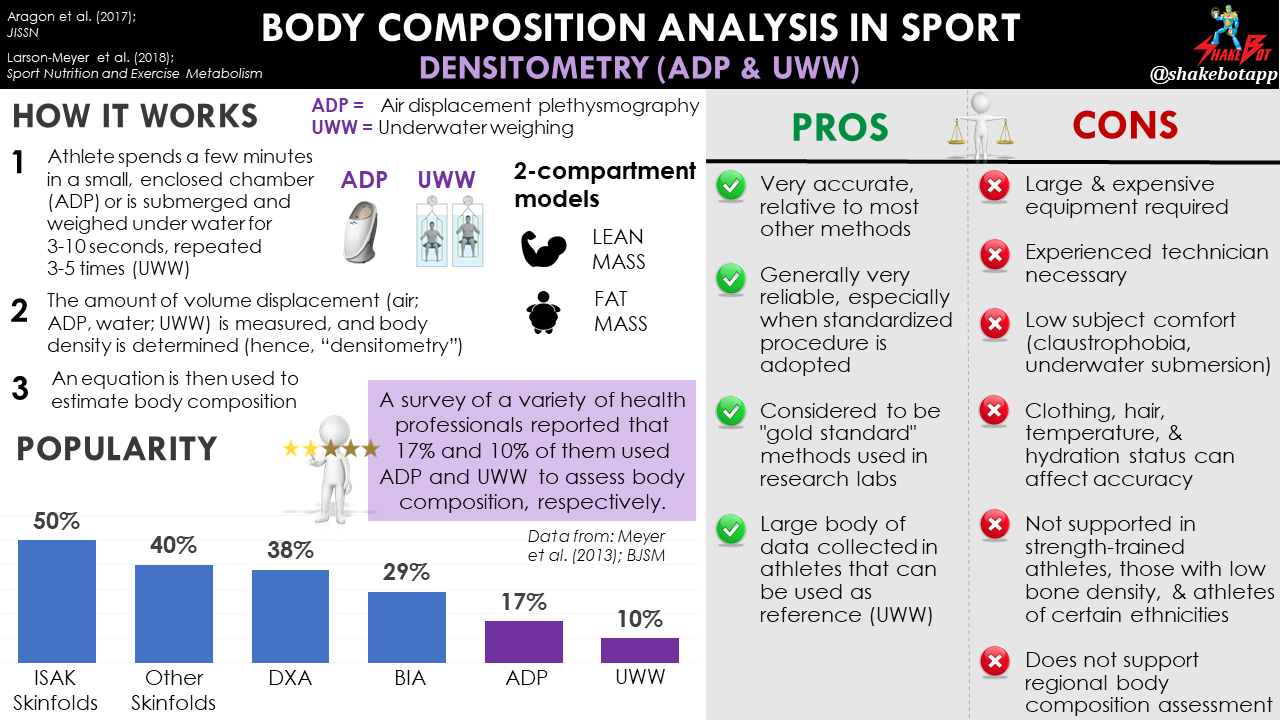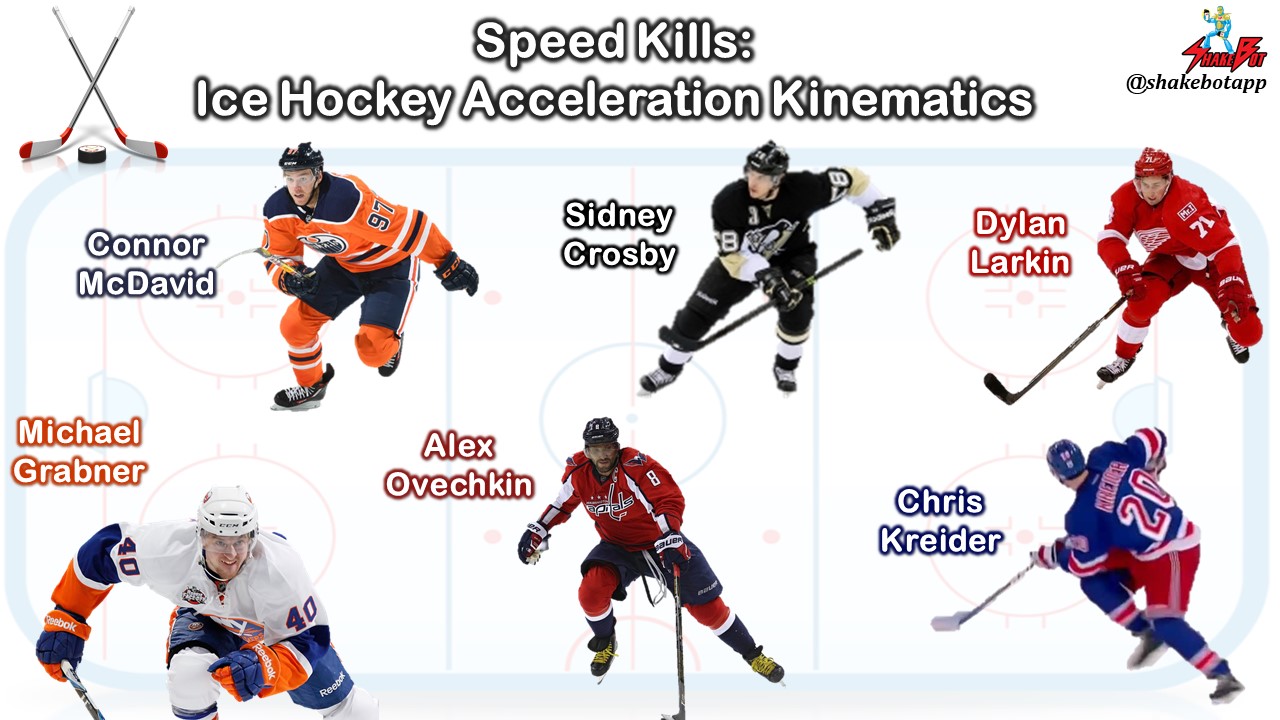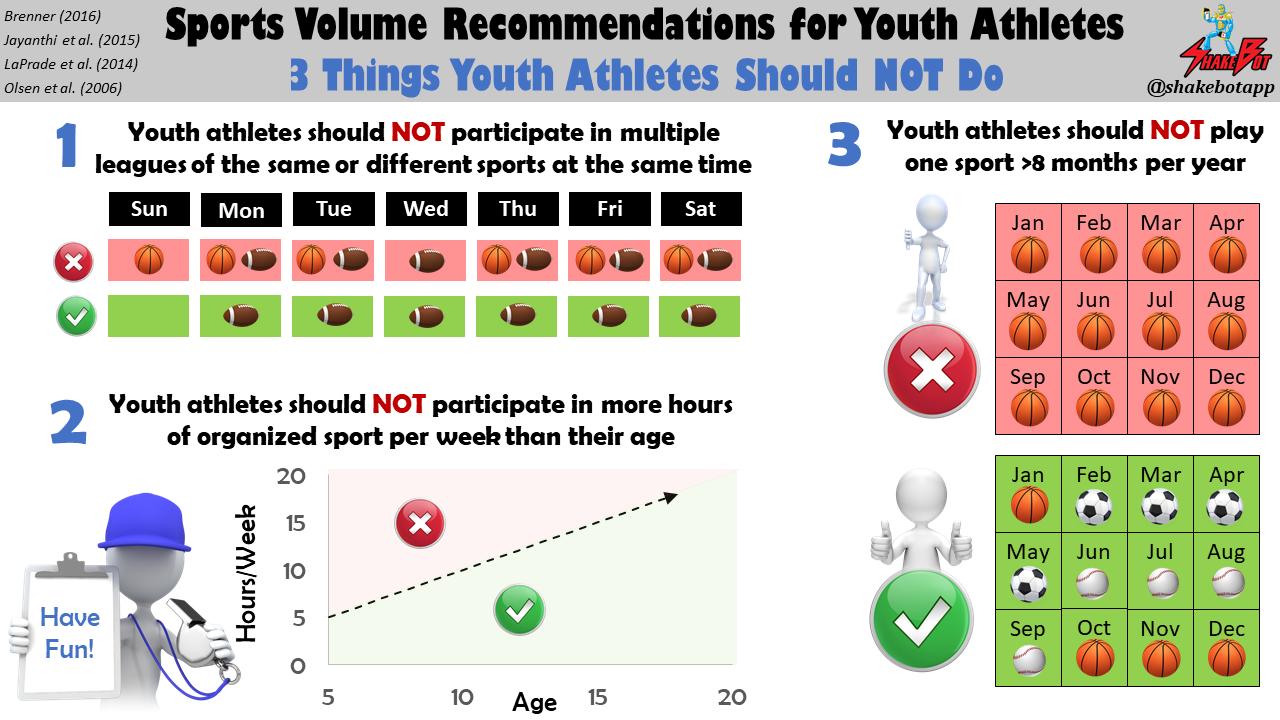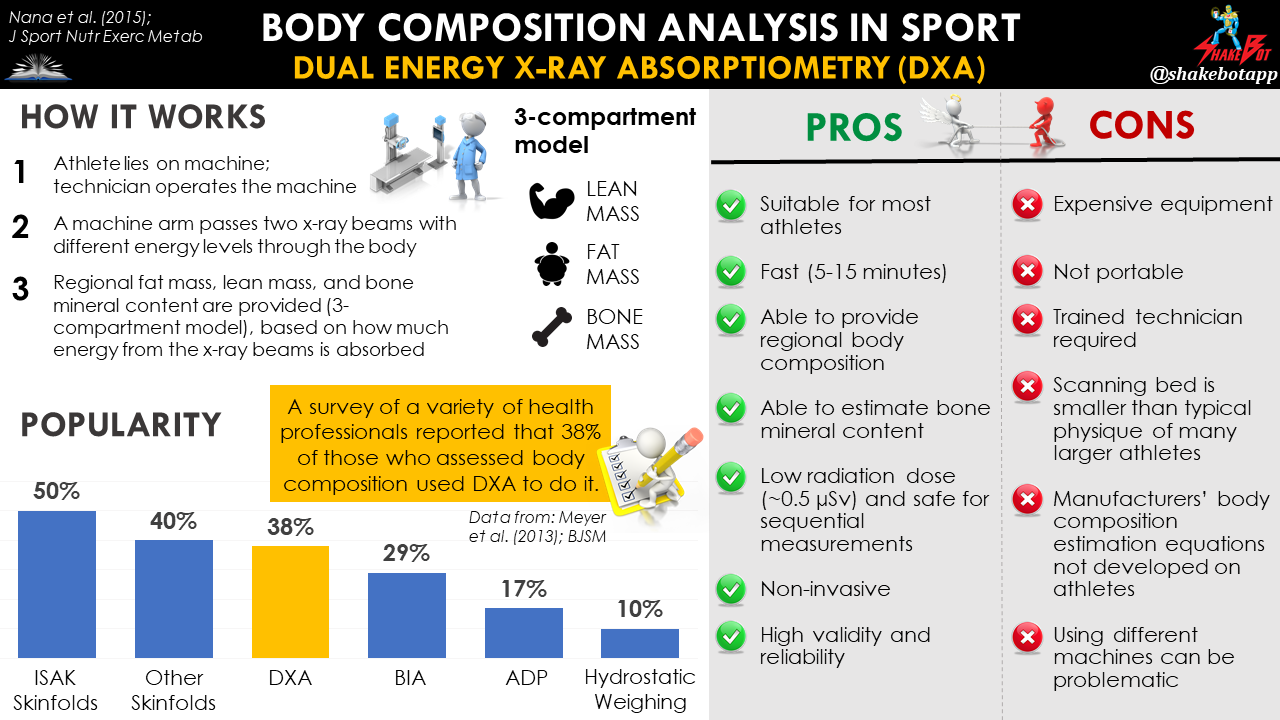Monitoring body composition in athletes is beneficial for a multitude of reasons. Air displacement plethsymography (ADP; BOD POD is the most common device) and underwater weighing (UWW) are two highly regarded methods for body composition assessment. How ADP and UWW work, their popularity among sport professionals, and common sources and margin of error are reviewed in this article.
Grey boxes are summary points
Blue boxes give more detail about key terms or subjects
Densitometry: How it Works
Underwater weighing (UWW) and air displacement plethysmography (ADP) are known as very accurate methods for measuring body volume, and have been considered “gold standard” strategies for body composition assessment [1, 2].
UWW = Underwater weighing. Subjects are required to exhale all of the air from their lungs (or as much as possible), and then be weighed underwater, which requires full body submersion. UWW is considered another “gold standard” method for body composition assessment. Conceptually, it’s similar to ADP, but is based on Archimedes’ principle, which estimates the subject’s body volume from the volume of water that becomes displaced when the subject is underwater. UWW estimates the breakdown of (1) lean mass, and (2) fat mass, inside the body.
ADP = Air displacement plethysmography. The subject is required to sit inside an enclosed chamber (plethysmograph), most commonly measured via a device called the BOD POD, which is considered another “gold standard” method for body composition assessment. It estimates the subject’s body volume from the air which is displaced when the subject is in the chamber and, using Boyle’s law (and the Siri equation), ADP estimates the breakdown of (1) lean mass, and (2) fat mass, inside the body.
Both methods use densitometry, or body density, to calculate body fat percentage. Here’s a little math.
Density equation: Body density = mass / volume
Density is quantified by grams per cubic centimeter (g/cm3). This metric will appear throughout the article.
Step on a weight scale. That’s your body mass (i.e. body weight). What else do we need to calculate body density? The missing link is volume, and that’s exactly what is determined by ADP and UWW (which are also termed volumetric techniques). Since body mass is known, once the body volume is measured via ADP or UWW, the body’s density is also known. Using the known fat mass and typical fat-free mass densities in humans (0.9 g/cm3 and 1.1 g/cm3, respectively), an equation is applied to estimate body composition.
Fat mass includes fat tissue, and nothing else. Therefore, the density of fat mass (0.9 g/cm3) is relatively constant. Fat-free mass, however, is composed of various things, each with a different density. Fat-free mass contains everything in the body that isn’t fat mass, which includes muscle, bone, organs, minerals, and water, among other components. For example, water, minerals, and protein are thought to have densities of 0.9937 g/cm3, 3.038 g/cm3, and 1.34 g/cm3, respectively [3]. Therefore, the relative quantities of these components in fat-free mass can affect the fat-free mass density. This is the biggest limitation of ADP and UWW for assessing body composition in athletes; there’s high inter-individual variation in the relative proportion of these components within fat-free mass, and Prior et al. (2001) found differences between males and females, and athletes and non-athletes [3]:
| Fat-free mass component | Density | Typical proportion in fat-free mass | Female nonathletes | Female athletes | Male nonathletes | Male athletes |
| Water | 0.9937 g/cm3 | 73.8% | 73.1% | 72.1% | 72.9% | 74.2% |
| Minerals | 3.038 g/cm3 | 6.8% | 6.2% | 6.1% | 6.3% | 5.8% |
| Protein | 1.34 g/cm3 | 19.4% | 20.6% | 21.8% | 20.8% | 20.0% |
Densitometry is a two-compartment model, as is skinfold assessment; that is, they estimate two body compartments, fat mass (FM) and fat-free mass (FFM). Since two-compartment models don’t further segregate FFM, they assume that bone mineral content (BMC), total body water (TBW), muscle, and protein fractions do not suffer from variation, which is clearly not the case [1, 3-9]. For example, Modlesky et al. (1996) observed that weight trainers had lower density of fat-free mass, compared with controls [8]. This is because the weight trainers had higher relative water fractions, and lower relative protein and mineral fractions in their fat-free mass, compared with controls [8]. Similarly, Millard-Stafford et al. (2001) found that resistance-trained males had lower density of fat-free mass, compared with control counterparts [9]. Each of these methods will be discussed individually. But, first, let’s talk a bit about the popularity of each.

Dr. Stephen Pintauro from the Department of Nutrition and Food Sciences at the University of Vermont created a really cool interactive tutorial on the subject, which can be accessed by here. Go Catamounts!
Popularity
National and international sport professionals who assess body composition prefer ADP to UWW (i.e. hydrostatic weighing), according to a 2013 survey [10]. However, these methods were the least popular compared with the other popular body composition assessment methods, including skinfold assessment, bioelectrical impedance analysis (BIA), and dual energy x-ray absorptiometry (DXA) . These results are unsurprising, given that ADP and UWW both require expensive equipment, trained technicians, and can be particularly troublesome or uncomfortable for the participants.

Aragon et al. (2017). International society of sports nutrition position stand: diets and body composition. Journal of the International Society of Sports Nutrition, 14(1), p.16.
Larson-Meyer et al. (2018). Assessment of nutrient status in athletes and the need for supplementation. International Journal of Sport Nutrition and Exercise Metabolism, 28(2), pp.139-158.
BIA = Bioelectrical impedance analysis. A method for body composition assessment that sends an imperceptible electrical current through the body. The conductivity differences among bodily tissues allows BIA to predict the breakdown of (1) lean mass, (2) fat mass, and (3) body water.
DXA = Dual energy x-ray absorptiometry. Passes filtered x-ray beams with two different photon energies (emitting a very small dose of ionizing radiation) through the body to produce pictures of the inside of the body, and is considered one of the “gold standard” methods for body composition assessment. DXA can estimate the breakdown of (1) lean mass, (2) fat mass, and (3) bone mineral content, by body segment, because each tissue differentiates photons differently.
Underwater Weighing (UWW)
UWW is based on Archimedes’ principle [11]. Rather than bore you with the details, you can see the instructional video below to gain a better understanding of the principle:
Lean tissues, such as muscle and bone, are denser than water, whereas fat tissue is less dense than water. If you’ve ever heard the phrase “a pound of muscle weighs more than a pound of fat,” this is concept that is being referred to. Any volume of fat-free (i.e. lean) mass will weigh more than the same volume of fat mass. When placed in water, a person made of mostly fat tissue is more buoyant and will float easily, whereas a person with significantly more lean mass will be less buoyant and sink like a rock. This is an overgeneralization, but I hope the inference helps: if you become more buoyant over time, you are carrying a higher percentage of body fat. If you become less buoyant over time, you have reduced your percentage of body fat (i.e. increased your percentage of lean mass).

Obtained from Ningthoujam et al., (2016). Underlying Principles and Theories of Common Body Composition Techniques: A Systematic Review. International Journal of Current Research. 8. 27939-27945.
UWW involves (1) being weighed on land, (2) estimation of lung residual volume (RV; the amount of air remaining inside a person’s lungs after complete exhalation), and (3) being weighed when fully submerged underwater. Wait, how the heck can you be weighed underwater? Well, UWW involves expensive equipment that allows for the individual being tested to sit on a special scale, which will be lowered slowly into the water until fully submerged. While the individual is fully submerged for 3-10 seconds, signals are sent to a digital computer, which calculates the underwater weight. This is repeated 3-5 times to ensure consistency in the weights.
Using body weight measured on land, lung residual volume, and body weight measured underwater, body density is determined [12, 13]. Body density is inserted into an equation termed the Siri equation, which was developed by Dr. William Siri and estimates body fat percentage [14, 15].
Siri Equation: % Body fat = ((4.95 / body density) – 4.5) * 100
Air Displacement Plethysmography (ADP)

Air displacement plethsymography.
Obtained from Ningthoujam et al., (2016). Underlying Principles and Theories of Common Body Composition Techniques: A Systematic Review. International Journal of Current Research. 8. 27939-27945.
If you’re thinking that UWW sounds like a pain in the a**… well, it is. Air displacement plethysmography (ADP) was developed as a more convenient alternative to UWW that’s more suitable for a wider range of people [1, 16]. Before ADP, the “gold standard” method for body composition assessment was UWW [17]. The principle used is similar, but ADP uses air displacement instead of water displacement to measure body volume [18]. While UWW uses Archimedes’ principle, ADP is based on Poisson’s Law; using the pressure-volume relationship at a fixed constant temperature, the volume of the athlete is calculated [53].
Although there is no water submersion involved with ADP, the subject is required to spend a few minutes in a small, enclosed chamber (plethysmograph), which can make some people feel claustrophobic. The most common device used is termed the Bod Pod. The Bod Pod device is, by far, the most prevalent device used for ADP; so much so that, sometimes, the terms “Bod Pod” and plethysmograph are used interchangeably. The subject simply sits in this enclosed chamber for a few minutes, and the ADP unit uses pressure and volume changes to determine body density, and estimates body composition [19].
Accuracy and Reliability
UWW and ADP have good agreement for measuring body composition in various populations, including athletes and healthy individuals [18-29]. Moon et al. (2007, 2008) compared various body composition methods, including bioelectrical impedance analysis, near-infared spectroscopy (NIR), skinfold assessment, ADP, UWW, using a 3-component model, in college-aged Caucasian men and women [23, 24]. In these experiments, ADP and UWW were found to be valid laboratory methods for body composition assessment [23, 24].
There are, usually, strong agreements between ADP and other very accurate methods, as well, including ultrasound (US) and dual energy x-ray absorptiometry (DXA), exemplified by a typical 1-4% difference in body fat percentage between methods [19, 27, 30-34]. However, this is not always the case [35, 36]. It’s important to understand that even if the difference between methods is <4%, this does not insinuate that the difference is not significant. For example, in a study in 29 elite collegiate ice hockey players by Delisle-Houde et al. (2017), ADP (BOD POD) understimated body fat percentage by 3.8%, compared with DXA, but the body fat percentages for many of the leaner players were underestimated by 6-8% via ADP [31]. Low bias and small individual error have been reported when using ADP and UWW, particularly in young healthy adults [19, 37, 38].
US = Ultrasound. Using a beam of skin-penetrating ultrasonic waves (i.e. high-frequency sound waves above the upper limit of human hearing) emitted by a transducer probe, body fat percentage is estimated based on the acoustic re?ection and impedance of different tissue borders. Similar to skinfold assessment, ultrasound is used to assess regional subcutaneous fat tissue. However, ultrasound measures the subcutaneous fat tissue thickness in a decompressed state (i.e. single layer), whereas skinfold assessment requires pinching of the skin and subsequent measurement of the same tissue in compressed state (i.e. double layer). Using a prediction equation, US estimates the breakdown of (1) lean mass, and (2) fat mass, inside the body.
Day-to-day reliability is considered to be excellent, generally [39-41]. However, the variation in the athletic cohort may be a bit higher than in the general population because athletes typically have larger amounts of muscle mass and, therefore, there may be more variance in the intramuscular components (water, mineral, bone, and protein fractions). Given the larger-than-normal variances and fluctuations in fat-free mass, the validity of ADP and UWW are compromised in athletes [21, 22, 31]. For this reason, some researchers advise against using these methods with strength-trained athletes or those with low bone density [42-44, 54].
It would be beneficial to use at least a three-compartment model, including total body water (TBW), in these populations because of the variance in muscle and bone mass. There’s a substantial body of research that suggests body composition estimation from UWW and ADP can be more accurate when combined with TBW assessment [1, 2, 42-47]. This approach is not always a pragmatic one, however.
Important Sources of Error to Consider
Variation in the intramuscular components at the time of measurement, such as bone mineral density (BMD) and hydration status, can also influence the validity and reliability of ADP and UWW methods [18, 21]. As stated at the beginning of this article, both of these methods assume a constant and known density of fat mass (FM) and fat-free mass (FFM) for all individuals, which is not necessarily the case [1, 3-9]. It’s important to consider that age [48], gender [3, 49, 50], ethnicity [51, 52], and amount of muscle mass [3, 8, 9] can dramatically influence results.
Additionally, the amount of air inside the body at the time of measurement can impact the results. In UWW, athletes are asked to try to expel all of the air in their lungs prior to underwater submersion, which can be a very difficult and uncomfortable thing to do. Variation in how much air is remaining in the lungs before submersion may lead to inaccurate results. In ADP, no maximal exhalation is required. Rather, athletes are asked to sit still and breath normally during the few minutes that they spend in the chamber, and an average lung volume during normal breathing is estimated. Variation in body movements and breathing patterns during, or across, measurements can alter the results.It’s important to understand the limitations of two-compartment models, such as UWW and ADP, and to acknowledge the factors that can influence interpretation of results.
As is the case with any method, adopting a standardized approach and educating the athletes on developing a consistent routine prior to assessment are critical for accurately assessing longitudinal changes in body composition.
Common advantages and disadvantages of using UWW and/or ADP are listed below [53-55]:
| Advantages | Disadvantages |
| Very accurate | Experienced technician required |
| Generally very reliable, especially with standardized procedure | Large, expensive equipment |
| Large body of data collected in athletes that can be used as reference (UWW) | Subject discomfort (claustrophobia for ADP; underwater submersion for UWW) |
| Considered to be “gold standard” methods used in research labs | Clothing, hair, temperature, & hydration status can affect accuracy |
| Not supported in strength-trained athletes, those with low bone density, and athletes of certain ethnicities | |
| Does not support regional body composition assessment |
Summary
Densitometric (i.e. volumetric) body composition methods, including air displacement plethysmography (ADP) and underwater weighing (UWW) are considered to be a few of the most accurate methods for body composition assessment. However, there are several hurdles that must be overcome in order to obtain accurate and reliable results, particularly in athletes. Although highly accurate methods, they are also two-compartment models (i.e. only measure fat mass and fat-free mass) which fail to capture regional body composition. Additionally, the high equipment cost, requirement for an experienced technician to be present, high degree of athlete participation, and potential discomfort are deterrents for their use, especially in elite athletes.
As is the case with any body composition assessment method, understanding the factors that affect the accuracy and reliability of ADP and UWW, and applying a standardized approach for data collection, is advised in order to avoid measurement artifact caused by these factors. In any case, the most important aspect of body composition assessment is the standardization of data collection. If standardization is lacking, misinterpretation of athlete physique is nearly certain [56].
Enjoying the Content?
Instantly become an important part of the Shakebot community by connecting with me on social media:
References
- Fosbøl, M.Ø. and Zerahn, B., 2015. Contemporary methods of body composition measurement. Clinical Physiology and Functional Imaging, 35(2), pp.81-97.
- Wang, Z., Deurenberg, P., Guo, S.S., Pietrobelli, A., Wang, J., Pierson Jr, R.N. and Heymsfield, S.B., 1998. Six-compartment body composition model: inter-method comparisons of total body fat measurement. International Journal of Obesity, 22(4), p.329.
- Prior, B.M., Modlesky, C.M., Evans, E.M., Sloniger, M.A., Saunders, M.J., Lewis, R.D. and Cureton, K.J., 2001. Muscularity and the density of the fat-free mass in athletes. Journal of Applied Physiology, 90(4), pp.1523-1531.
- Nana, A., Slater, G.J., Hopkins, W.G. and Burke, L.M., 2012. Effects of daily activities on dual-energy X-ray absorptiometry measurements of body composition in active people. Medicine & Science in Sports & Exercise, 44(1), pp.180-189.
- Nana, A., Slater, G. J., Hopkins, W. G., & Burke, L. M. (2013). Effects of exercise sessions on DXA measurements of body composition in active people. Medicine & Science in Sports & Exercise, 45(1), 178-185.
- Saunders, M.J., Blevins, J.E. and Broeder, C.E., 1998. Effects of hydration changes on bioelectrical impedance in endurance trained individuals. Medicine and Science in Sports and Exercise, 30(6), pp.885-892.
- Smith-Ryan, A.E., Mock, M.G., Ryan, E.D., Gerstner, G.R., Trexler, E.T. and Hirsch, K.R., 2017. Validity and reliability of a 4-compartment body composition model using dual energy X-ray absorptiometry-derived body volume. Clinical Nutrition, 36(3), pp.825-830.
- Modlesky, C.M., Cureton, K.J., Lewis, R.D., Prior, B.M., Sloniger, M.A. and Rowe, D.A., 1996. Density of the fat-free mass and estimates of body composition in male weight trainers. Journal of Applied Physiology, 80(6), pp.2085-2096.
- Millard-Stafford, M.L., Collins, M.A., Modlesky, C.M., Snow, T.K. and Rosskopf, L.B., 2001. Effect of race and resistance training status on the density of fat-free mass and percent fat estimates. Journal of Applied Physiology, 91(3), pp.1259-1268.
- Meyer, N.L., Sundgot-Borgen, J., Lohman, T.G., Ackland, T.R., Stewart, A.D., Maughan, R.J., Smith, S. and Müller, W., 2013. Body composition for health and performance: a survey of body composition assessment practice carried out by the Ad Hoc Research Working Group on Body Composition, Health and Performance under the auspices of the IOC Medical Commission. Br J Sports Med, pp.bjsports-2013.
- Nieman, D.C., 2003. Exercise testing and prescription: a health-related approach (Vol. 5). New York: McGraw-Hill.
- Behnke, A.R., Free, B.G. and Welham, W.C., 1942. The specific gravity of health man: Body weight-volume as index of obesity. JAMA, 118, pp.945-948.
- Biaggi, R.R., Vollman, M.W., Nies, M.A., Brener, C.E., Flakoll, P.J., Levenhagen, D.K., Sun, M., Karabulut, Z. and Chen, K.Y., 1999. Comparison of air-displacement plethysmography with hydrostatic weighing and bioelectrical impedance analysis for the assessment of body composition in healthy adults–. The American Journal of Clinical Nutrition, 69(5), pp.898-903.
- Siri, W.E., 1993. Body composition from fluid spaces and density: analysis of methods. 1961. Nutrition (Burbank, Los Angeles County, Calif.), 9(5), p.480.
- Brožek, J., Grande, F., Anderson, J.T. and Keys, A., 1963. Densitometric analysis of body composition: revision of some quantitative assumptions. Annals of the New York Academy of Sciences, 110(1), pp.113-140.
- Gnaedinger, R.H., Reineke, E.P., Pearson, A.M., Van Huss, W.D., Wessel, J.A. and Montoye, H.J., 1963. Determination of body density by air displacement, helium dilution, and underwater weighing. Annals of the New York Academy of Sciences, 110(1), pp.96-108.
- Dempster, P. and Aitkens, S., 1995. A new air displacement method for the determination of human body composition. Medicine and Science in Sports and Exercise, 27(12), pp.1692-1697.
- Collins, M.A., Millard-Stafford, M.L., Sparling, P.B., Snow, T.K., Rosskopf, L.B., Webb, S.A. and Omer, J., 1999. Evaluation of the BOD POD for assessing body fat in collegiate football players. Medicine and Science in Sports and Exercise, 31(9), pp.1350-1356.
- Schoenfeld, B.J., Aragon, A.A., Moon, J., Krieger, J.W. and Tiryaki?Sonmez, G., 2017. Comparison of amplitude?mode ultrasound versus air displacement plethysmography for assessing body composition changes following participation in a structured weight?loss programme in women. Clinical Physiology and Functional Imaging, 37(6), pp.663-668.
- Noreen, E.E. and Lemon, P.W., 2006. Reliability of air displacement plethysmography in a large, heterogeneous sample. Medicine and Science in Sports and Exercise, 38(8), pp.1505-1509.
- Vescovi, J.D., Zimmerman, S.L., Miller, W.C., Hildebrandt, L., Hammer, R.L. and Fernhall, B., 2001. Evaluation of the BOD POD for estimating percentage body fat in a heterogeneous group of adult humans. European Journal of Applied Physiology, 85(3-4), pp.326-332.
- Levenhagen, D.K., Borel, M.J., Welch, D.C., Piasecki, J.H., Piasecki, D.P., Chen, K.Y. and Flakoll, P.J., 1999. A comparison of air displacement plethysmography with three other techniques to determine body fat in healthy adults. Journal of Parenteral and Enteral Nutrition, 23(5), pp.293-299.
- Moon, J.R., Hull, H.R., Tobkin, S.E., Teramoto, M., Karabulut, M., Roberts, M.D., Ryan, E.D., Kim, S.J., Dalbo, V.J., Walter, A.A. and Smith, A.T., 2007. Percent body fat estimations in college women using field and laboratory methods: a three-compartment model approach. Journal of the International Society of Sports Nutrition, 4(1), p.16.
- Moon, J.R., Tobkin, S.E., Smith, A.E., Roberts, M.D., Ryan, E.D., Dalbo, V.J., Lockwood, C.M., Walter, A.A., Cramer, J.T., Beck, T.W. and Stout, J.R., 2008. Percent body fat estimations in college men using field and laboratory methods: A three-compartment model approach. Dynamic Medicine, 7(1), p.7.
- Ferri-Morales, A., Nascimento-Ferreira, M.V., Vlachopoulos, D., Ubago-Guisado, E., Torres-Costoso, A., De Moraes, A.C.F., Barker, A.R., Moreno, L.A., Martínez-Vizcaino, V. and Gracia-Marco, L., 2018. Agreement Between Standard Body Composition Methods to Estimate Percentage of Body Fat in Young Male Athletes. Pediatric Exercise Science, 20(XX), pp.1-9.
- Brown, D., Mackenzie, J., Dennis, K. and Cullen, R., 2006. Comparison of body composition techniques to determine body fat in high school wrestlers. JEP Online, 9(3), pp.24-32.
- Utter, A.C., Goss, F.L., Swan, P.D., Harris, G.S., Robertson, R.J. and Trone, G.A., 2003. Evaluation of air displacement for assessing body composition of collegiate wrestlers. Medicine & Science in Sports & Exercise, 35(3), pp.500-505.
- Bentzur, K.M., Kravitz, L. and Lockner, D.W., 2008. Evaluation of the BOD POD for estimating percent body fat in collegiate track and field female athletes: a comparison of four methods. The Journal of Strength & Conditioning Research, 22(6), pp.1985-1991.
- Dixon, C.B., Deitrick, R.W., Pierce, J.R., Cutrufello, P.T. and Drapeau, L.L., 2005. Evaluation of the BOD POD and leg-to-leg bioelectrical impedance analysis for estimating percent body fat in National Collegiate Athletic Association Division III collegiate wrestlers. The Journal of Strength & Conditioning Research, 19(1), pp.85-91.
- Lowry, D.W. and Tomiyama, A.J., 2015. Air displacement plethysmography versus dual-energy x-ray absorptiometry in underweight, normal-weight, and overweight/obese individuals. PloS One, 10(1), p.e0115086.
- Delisle-Houde, P., Reid, R.E., Insogna, J.A., Prokop, N.W., Buchan, T.A., Fontaine, S.L. and Andersen, R.E., 2017. Comparing DXA and Air-Displacement-Plethysmography to Assess Body Composition of Male Collegiate Hockey Players. Journal of Strength and Conditioning Research.
- Bi, X., Loo, Y.T. and Henry, C.J., 2018. Body Fat Measurements in Singaporean Adults Using Four Methods. Nutrients, 10(3), p.303.
- Merrigan, J., Gallo PhD, S., Fields, J. and Jones PhD, M.T., 2018. Foot-to-Foot Bioelectrical Impedance, Air Displacement Plethysmography, and Dual Energy X-ray Absorptiometry in Resistance-Trained Men and Women. International Journal of Exercise Science, 11(4), pp.1145-1155.
- Berges, G.L., Llorente, Á.M., Bruton, A.G., Agüero, A.G., Rodríguez, G.V. and Casajús, J.A., 2017. Body fat percentage comparisons between four methods in young football players: are they comparable?. Nutricion Hospitalaria, 34(5).
- Wagner, D.R., Cain, D.L. and Clark, N.W., 2016. Validity and reliability of A-mode ultrasound for body composition assessment of NCAA division I athletes. PloS One, 11(4), p.e0153146.
- Johnson, K.E., Miller, B., Gibson, A.L., McLain, T.A., Juvancic?Heltzel, J.A., Kappler, R.M. and Otterstetter, R., 2017. A comparison of dual?energy X?ray absorptiometry, air displacement plethysmography and A?mode ultrasound to assess body composition in college?age adults. Clinical Physiology and Functional Imaging, 37(6), pp.646-654.
- Jensky-Squires, N.E., Dieli-Conwright, C.M., Rossuello, A., Erceg, D.N., McCauley, S. and Schroeder, E.T., 2008. Validity and reliability of body composition analysers in children and adults. British Journal of Nutrition, 100(4), pp.859-865.
- Millard-Stafford, M.L., Collins, M.A., Evans, E.M., Snow, T.K., Cureton, K.J. and Rosskopf, L.B., 2001. Use of air displacement plethysmography for estimating body fat in a four-component model. Medicine and Science in Sports and Exercise, 33(8), pp.1311-1317.
- Schubert, M.M., Seay, R.F., Spain, K.K., Clarke, H.E. and Taylor, J.K., 2018. Reliability and validity of various laboratory methods of body composition assessment in young adults. Clinical Physiology and Functional Imaging.
- Bailey, B.W., LeCheminant, G., Hope, T., Bell, M. and Tucker, L.A., 2018. A comparison of the agreement, internal consistency, and 2-day test stability of the InBody 720, GE iDXA, and BOD POD® gold standard for assessing body composition. Measurement in Physical Education and Exercise Science, pp.1-8.
- Gibby, J.T., Njeru, D.K., Cvetko, S.T., Heiny, E.L., Creer, A.R. and Gibby, W.A., 2017. Whole-Body Computed Tomography–Based Body Mass and Body Fat Quantification: A Comparison to Hydrostatic Weighing and Air Displacement Plethysmography. Journal of Computer Assisted Tomography, 41(2), pp.302-308.
- Clasey, J.L., Kanaley, J.A., Wideman, L., Heymsfield, S.B., Teates, C.D., Gutgesell, M.E., Thorner, M.O., Hartman, M.L. and Weltman, A., 1999. Validity of methods of body composition assessment in young and older men and women. Journal of Applied Physiology, 86(5), pp.1728-1738.
- Withers, R.T., Laforgia, J., Pillans, R.K., Shipp, N.J., Chatterton, B.E., Schultz, C.G. and Leaney, F., 1998. Comparisons of two-, three-, and four-compartment models of body composition analysis in men and women. Journal of Applied Physiology, 85(1), pp.238-245.
- Moon, J.R., Eckerson, J.M., Tobkin, S.E., Smith, A.E., Lockwood, C.M., Walter, A.A., Cramer, J.T., Beck, T.W. and Stout, J.R., 2009. Estimating body fat in NCAA Division I female athletes: a five-compartment model validation of laboratory methods. European Journal of Applied Physiology, 105(1), pp.119-130.
- Sun, S.S., Chumlea, W.C., Heymsfield, S.B., Lukaski, H.C., Schoeller, D., Friedl, K., Kuczmarski, R.J., Flegal, K.M., Johnson, C.L. and Hubbard, V.S., 2003. Development of bioelectrical impedance analysis prediction equations for body composition with the use of a multicomponent model for use in epidemiologic surveys. The American Journal of Clinical Nutrition, 77(2), pp.331-340.
- Bosy-Westphal, A., Mast, M., Eichhorn, C., Becker, C., Kutzner, D., Heller, M. and Müller, M.J., 2003. Validation of air-displacement plethysmography for estimation of body fat mass in healthy elderly subjects. European Journal of Nutrition, 42(4), pp.207-216.
- Kendall, K.L., Fukuda, D.H., Hyde, P.N., Smith-Ryan, A.E., Moon, J.R. and Stout, J.R., 2017. Estimating fat-free mass in elite-level male rowers: a four-compartment model validation of laboratory and field methods. Journal of Sports Sciences, 35(7), pp.624-633.
- Lohman, T.G., 1986. Applicability of body composition techniques and constants for children and youths. Exercise and Sport Sciences Reviews, 14, pp.325-357.
- Chung, J.Y., Kang, H.T., Lee, D.C., Lee, H.R. and Lee, Y.J., 2013. Body composition and its association with cardiometabolic risk factors in the elderly: a focus on sarcopenic obesity. Archives of Gerontology and Geriatrics, 56(1), pp.270-278.
- Visser, M., Gallagher, D., Deurenberg, P., Wang, J., Pierson Jr, R.N. and Heymsfield, S.B., 1997. Density of fat-free body mass: relationship with race, age, and level of body fatness. American Journal of Physiology-Endocrinology and Metabolism, 272(5), pp.E781-E787.
- Wagner, D.R. and Heyward, V.H., 2000. Measures of body composition in blacks and whites: a comparative review. The American Journal of Clinical Nutrition, 71(6), pp.1392-1402.
- Deurenberg-Yap, M., Schmidt, G., van Staveren, W.A., Hautvast, J.G. and Deurenberg, P., 2001. Body fat measurement among Singaporean Chinese, Malays and Indians: a comparative study using a four-compartment model and different two-compartment models. British Journal of Nutrition, 85(4), pp.491-498.
- Ackland, T.R., Lohman, T.G., Sundgot-Borgen, J., Maughan, R.J., Meyer, N.L., Stewart, A.D. and Müller, W., 2012. Current status of body composition assessment in sport. Sports Medicine, 42(3), pp.227-249.
- Larson-Meyer, D.E., Woolf, K. and Burke, L., 2018. Assessment of nutrient status in athletes and the need for supplementation. International Journal of Sport Nutrition and Exercise Metabolism, 28(2), pp.139-158.
- Aragon, A.A., Schoenfeld, B.J., Wildman, R., Kleiner, S., VanDusseldorp, T., Taylor, L., Earnest, C.P., Arciero, P.J., Wilborn, C., Kalman, D.S. and Stout, J.R., 2017. International society of sports nutrition position stand: diets and body composition. Journal of the International Society of Sports Nutrition, 14(1), p.16.
- Kerr, A.D., Slater, G.J. and Byrne, N.M., 2018. Influence of subject presentation on interpretation of body composition change after 6 months of self-selected training and diet in athletic males. European Journal of Applied Physiology, 118(6), pp.1273-1286.








